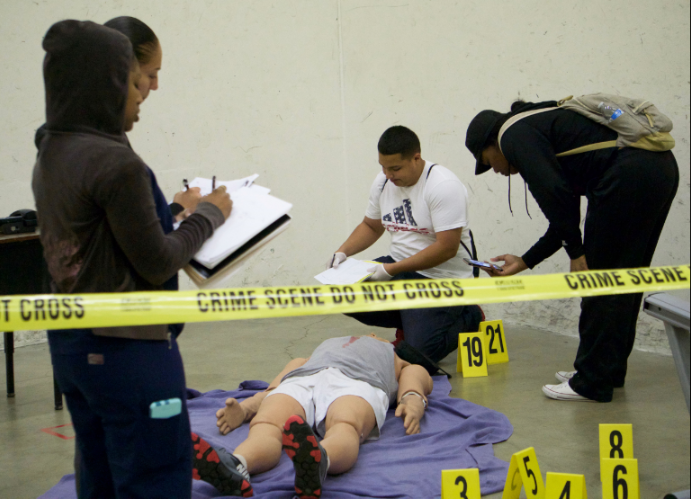Mock murder tests student skills
From left to right: Emm West, Naomi Valladares, Richard Tovar and Elexus Thurman examine the mock murder scene on March 23.
March 30, 2017
A fake crime scene was set up at the Bakersfield College gymnasium for a criminal justice class learning about forensic evidence.
Teachers Patricia Smith and Harlan Hunter set up the crime scene for their class to get a better understanding of how a real crime scene would go through investigation.
The crime scene was located under the BC gym near the racquetball courts. Students would go into the room and try to solve the crime with little knowledge of the scene.
Patricia Smith, a BC criminal justice professor, explained the reason for these hands-on activities and how it will better prepare a student for a real life situation when they are out in the field.
She said in this mock scenario, that individuals were working out, and a drug deal ensued and went bad.
“Someone owed someone money to the other, and they got in a fight and one got shot,” she said.
“Before this activity, we were talking about the evidence commonly found at crime scenes, so we’ve been around blood, spatter, and blood patterns, ballistics and all different types of evidence, and finger prints. “In class, we also have a chapter on just crime scenes, and we have had officers come to our class and talk about police work,” she said.
The students can’t do real lab work because, Smith said, “we don’t have a lab, but we just talk about a criminal justice type of approach and how to handle a crime scene and how to protect a crime scene.
“So now they’re trying to put everything together we learned in class and figuring it all out by analyzing the crime scene, and what took place [in the crime scene]. Of course, this is not a real crime scene, this is a mock crime scene, they’re learning how to write a report, because I taught them that in order to convict and prosecute they have to go through the crime scene very thoroughly,” said Smith.
The eight individual teams that went into the crime scene March 21 and March 23 had no idea, when they first went in, what they were looking at, just the bit of information they were provided about the crime scene. The eight teams had individual tasks: a report writer also known as the lead investigator, a photographer, an evidence collector and a sketcher. As they all examined at the crime scene, one of the individuals set down markers (donated by the Bakersfield Police Department) on any items they classify as evidence. The dummy that played the victim of the crime scene was donated by Allied Health to professor Harlan Hunter.
The crime scene didn’t finish in the gym. More scenes were conducted around the campus in the Athletics Department. The group asked a mock witness to the crime who they saw go into the gym, and if he was alone or did he go with another individual.
Kenjiro Rivas, a student in the criminal justice class who is looking to become a lawyer, shared his thoughts on the activity and how it could help him later in life.
“At first the activity seemed exciting, but once you’re in there it became more serious, and it just hit me with what the officers go through, and even though I knew the body was fake, it still felt weird feeling like there was an actual person laying there, with the blood looking like it was really coming out of him and this crime scene actually happened,” Rivas said.
“When looking at the body, the first thing I thought is where do I start? I know there is yellow tape around the scene so I now know where it starts, and from there it started getting easier and started going off step by step, like here’s the money, here’s the drugs and we start piecing things together,” said Rivas.
He also found it easier working with the team. “I found it easier [working with a team] because you’re trying to figure out a case and with a team, you come up with different ideas and different views.” Another student, Noemi Valladares, who plans on becoming a police or correctional officer, also liked the activity and found it very helpful for the type of career she is looking for.
“I found it really fun, so I think it’s something I would expect when I become a probation officer or police officer, and I now know what I’m going to run into when I’m at a crime scene,” Valladares said. “The challenging thing about it was trying to figure out what happened, ’cause when there is a lot of evidence, you just don’t know what happened.”





